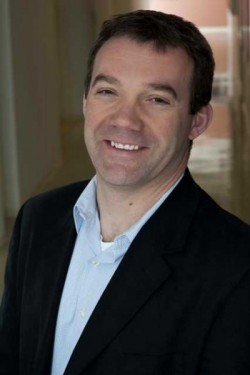
Tom Learner is senior scientist at the Getty Conservation Institute (GCI) and the person responsible for the Pacific Standard Time exhibition From Start to Finish: De Wain Valentine’s Gray Column, which has received a lot of positive press reaction, including a recent article in the New York Times.
Richard McCoy: How did you arrive at your position of conservation scientist?
Tom Learner: I was trained as a chemist at University of Oxford and always loved chemistry and science; I also always loved art. But when I was finishing my degree I realized that I had stopped enjoying chemistry.
Eventually I went to see a career advisor and sat in his office for hours and hours. He asked me if I was interested in all sorts of things from research in forensics or pharmaceuticals, to teaching, even to the financial sector. I said no to them all. Eventually he pulled this scrap of paper from the bottom of his pile, dusted it off, and said “apparently art conservation is looking for students with science backgrounds.”
And for me it was one of these moments when something really clicks. From there I went on to an internship at the Ashmolean Museum, and then into the paintings conservation program at the Courtauld Institute of Art. I was offered an internship at the National Gallery of Art (NGA) in Washington, D.C. working six months with Sarah Fisher in paintings conservation and six months with René de la Rie in the Scientific Research Department. After that, a research fellowship became available at the Tate in their Science Department—to figure out the best ways to analyze modern and synthetic paints.
I got my PhD at Birkbeck College at the same time, and once the fellowship finished the Tate kept me on in a permanent position.
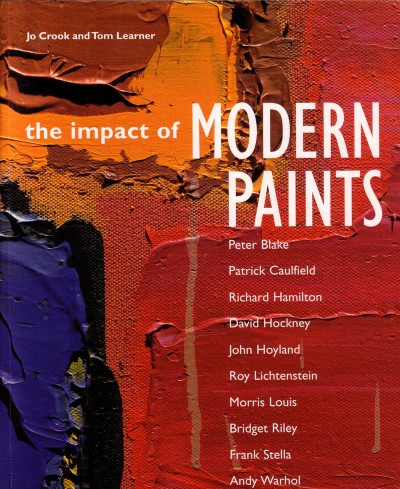
"The Impact of Modern Paints" by Jo Crook and Tom Learner.
RM: So this position led you to the opportunity to co-author the publication The Impact of Modern Paints?
TL: That book started with a quite rare situation in which the Tate publishing department was inviting ideas for conservation books and so my colleague, Jo Crook, and I suggested this idea that we would discuss the various types of synthetic paint via a technical study on 10 artists that used them in the 60s (for example Bridget Riley, Morris Louis, David Hockney, and Frank Stella). The artists we dealt with were really interested in this study, and it gave me a great taste of talking to artists. This research came together as the 2000 publication The Impact of Modern Paints. Also, in 2005, the Getty published my PhD Thesis as Analysis of Modern Paints.
The Getty later published the proceedings from Modern Paints Uncovered, a conference that I organized with colleagues from the Tate, the NGA, and the GCI, which took place at Tate Modern in 2006.
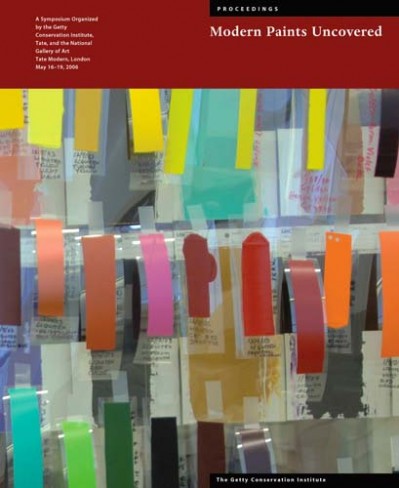
"Modern Paints Uncovered." Proceedings from the Symposium, May 2006, Tate Modern, London.
RM: In 2007 you left the Tate to take a position at the GCI to lead their Modern and Contemporary Art Research initiative, and shortly thereafter produced the ground-breaking symposium, The Object in Transition, which moves out of a scientific or practical line of investigation into a more ethical, theoretical, or idea-based inquiry.
TL: I think in many (if not all) areas of conservation, it can be pretty limiting to make projects solely scientific or practical; we also have to address aesthetic and ethical issues.
There have been several excellent conferences on this aspect, of course, but I always found it difficult to draw parallels between problems encountered with artworks by different artists. For example, colleagues would respond to issues about Marcel Duchamp with their experiences on works by Donald Judd or Eve Hesse. Always fascinating discussions, but somewhat frustrating too, because so many different considerations were being discussed in the same breath.
So with Object in Transition we wanted to focus on particular artists, and often single artworks, and ask diverse voices to discuss that same artwork. In addition to hearing different opinions over artists’ intent, for example, we worked to get speakers to open up over a range of conservation treatment issues. One of the other ideas the conference tried to address was the need to become more comfortable with the fact that we are unlikely to come up with definite answers to many of the conservation issues being posed by contemporary art.
RM: I didn’t attend the conference, but I’ve appreciated the opportunity to watch the entire conference on the Getty’s webpage. Do you think the online videos translate a similar message that was delivered in person?
TL: They do a pretty good job, yes. But one thing that doesn’t translate well is the fact that many of the artworks being discussed were actually on view at the Getty Museum during the conference. Take Eve Hesse’s 1969 work Expanded Expansion, for example. In the most recent photographs published by the Guggenheim, you can see the piece has become brown and brittle.
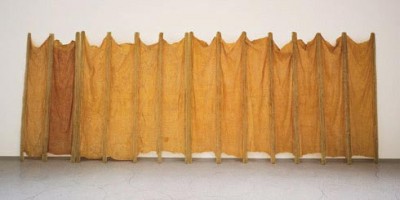
Eva Hesse. "Expanded Expansion," 1969. Reinforced fiberglass poles and rubberized cheesecloth. Solomon R. Guggenheim Museum, New York,Gift, Family of Eva Hesse. Photo: David Heald.
But at the symposium we showed sections of the original piece alongside a material mock up of a segment that was made by Doug Johns, Hesse’s assistant, in collaboration with the Guggenheim Museum, who own the artwork. Walking past the mock-up was really extraordinary because the slightest air movement caused the latex-impregnated cheese cloth to sway and move—which most definitely did not occur with the embrittled original. You could also smell the materials in the air.
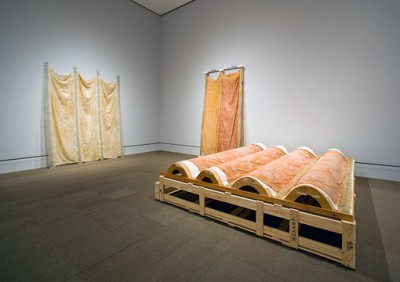
Two Sections of Eva Hesse's "Exanded Expansion" (right) and a material mock-up (left) of the same work on display at the Getty Museum as part of the 'Object in Transition' conference. Getty Photo: John Kiffe.
These things—pretty important to the overall experience of the work—clearly only can be experienced in person. We’ve received a lot of positive feedback from this symposium, so we’re very keen to do a follow up, using a similar format.
RM: I really like your exhibition From Start to Finish: De Wain Valentine’s ‘Gray Column‘ that’s currently on view at the Getty Museum. I know there have been conservation-focused exhibitions at the Getty Museum in the past, but is this the first one that’s focused on a contemporary artwork?
TL: Yes, it is. From Start to Finish is one of the exhibitions organized for the LA-wide Pacific Standard Time project, and it complements the largest of the Getty’s four exhibitions: Pacific Standard Time: Crosscurrents in L.A. Painting and Sculpture, 1950–1970.
It draws on much of the research we’ve undertaken on several of the Southern Californian artists from the era. We felt it was an important opportunity to talk specifically about technical, conservation, and ethical issues in a more public way.

De Wain Valentine. "Gray Column," 1975–76. Polyester resin.
For this project we wanted to maximize the opportunity to delve into the difficult issues that conservators confront. Gray Column has changed over time and there are a lot of questions about how it should be shown, or if it should be changed back to some previous state. These aren’t difficult concepts to grasp; the difficulty is how you deal with them, and who is involved in making the decisions around how the artwork should look in the gallery.
Recently I met someone up in the exhibition who told me he had no interest in contemporary art or conservation, and that this “Gray Column thing” meant nothing to him. But we continued talking and once the conversation moved to the fact that sandpaper today is far finer than that available in the 1970s, and that therefore De Wain could produce a much smoother finish today with these materials, he suddenly became hooked by the dilemma of whether that would be appropriate or not.
In the end, we’ve made an ambitious project: there’s the gallery exhibition, the web site, and a corresponding book that comes with a video on a DVD. Also, I’ve video-recorded an interview with De Wain, and we’ve done panel discussions, curatorial talks, and even have postcards, all the time trying to talk about conservators’ work in this area. This exhibition doesn’t address all of the issues in the conservation of modern and contemporary art, but it does address some of the important ones.
RM: I think this notion of finish can cross over to a notion of patina in that they both get to the question of how this two-ton artwork from the mid 1970s should and can look in 2012.
TL: I think that’s right. Most of the conservators that have seen the piece value the surface that has emerged over the years and talk about it in very similar terms to patina. The resin has this peculiar property in that areas of it will continue to flow after the overall slab has cured. The result is these slight ridges that develop on the surface. Sometimes this can be quite disturbing, but overall, the surface is pretty subtle and rather beautiful.
However, De Wain feels this emerging surface is not his original intent, so it should be removed. The trouble is, if you remove or reduce the surface changes this would be very invasive (sanding the entire surface down to a very flat surface). But we convinced De Wain to allow us to show the piece un-sanded (apart from the removal of the most distracting local scratches and damages).
We’re not trying to say that what we’ve done is the “right way.” We’re trying to explain the different approaches that could be taken, and—ultimately—ensure that the full variety of approaches still remain available to the artwork.
RM: At the Tate and at the GCI you’ve had the privilege to lead inquiries into some of the most relevant and timely conservation issues. I think to start a serious inquiry is in some ways really enough for right now. What is your over-arching game plan for your research?
TL: Even though I think I achieved a lot at the Tate, there’s no doubt about it, I’m in an extraordinarily privileged position at the GCI—everything from the financial resources, to the people I work with, to the analytical equipment we have in the science lab, to the support I get from my directors (and even the view: most days I look out over Beverly Hills to see a snow-capped Big Bear Mountain—it’s just incredible).
But with this privilege also comes a great sense of responsibility, that everything we do should benefit the field in a significant way. To me, that’s why the GCI exists.
Working for most museums or as a conservator in private practice, there’s no way you can take on large-scale projects—or to put the levels of resources into an exhibition like we were able to with From Start to Finish. I try to remember this when we’re thinking through projects and trying to decide what to work on. And I think the best way to answer those who resent our financial advantage is to put the money to good use, in ways that as many in the field as possible can benefit. That said, even the GCI doesn’t have limitless resources—we still have to make difficult decisions over priorities.
But it also can’t just be us doing this work. So another way we can help to benefit the field is to convince and enable others to participate in collaborations.
RM: I think your De Wain Valentine project is a model to emulate. It doesn’t have to be done to the same level every time or at every institution—it can exists on different scales—but there should be more like it.
TL: Thanks! There are all kinds of things that can be done around conservation projects like this and it’s been a really rewarding experience getting a little creative.




Pingback: Wednesday links | Tyler Green: Modern Art Notes | ARTINFO.com